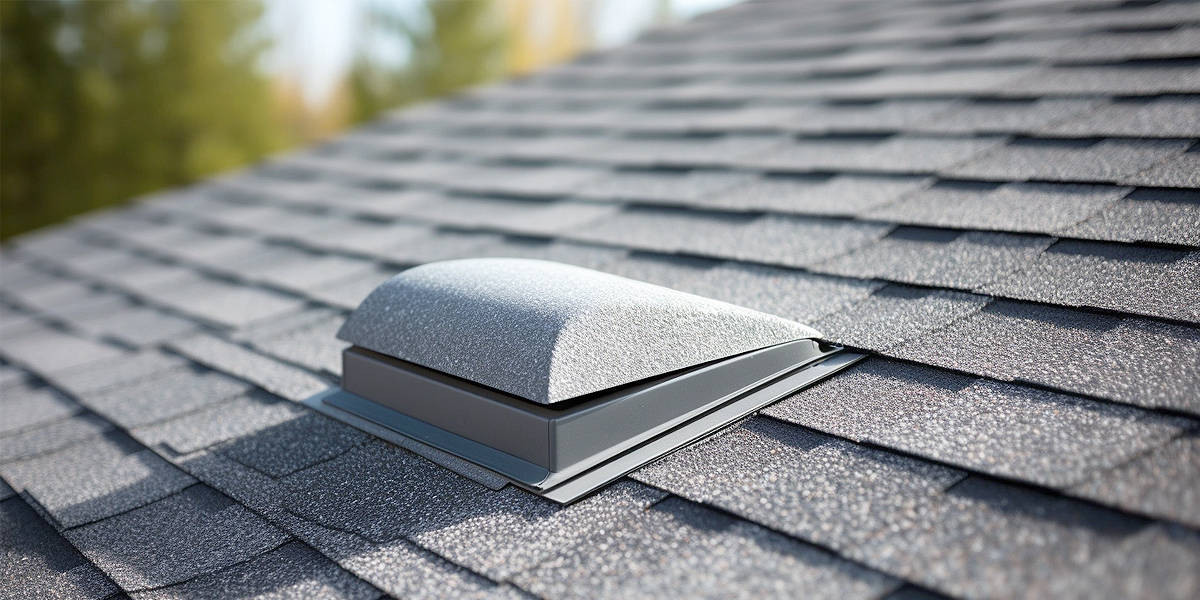Roof ventilation plays a crucial role in maintaining a healthy and comfortable living environment within a building. It involves the process of allowing air to flow freely through the space between the roof and the ceiling, ensuring proper circulation and exchange of air. In this article, we will explore the importance of roof ventilation, its benefits, and how a well-designed roof ventilation system can contribute to the overall well-being of a structure.
Proper roof ventilation is essential for several reasons. Firstly, it helps regulate temperature extremes by allowing hot air to escape during warmer months and preventing condensation buildup in colder seasons. This not only enhances indoor comfort but also reduces energy consumption by minimizing reliance on heating or cooling systems.
Furthermore, roof ventilation plays a crucial role in preventing moisture-related issues such as mold growth and rotting of structural components. By allowing moisture-laden air to escape, it helps maintain optimal humidity levels within the building, reducing the risk of damage to insulation materials and wooden structures.
In addition to temperature regulation and moisture control, roof ventilation offers several other benefits. It helps prolong the lifespan of roofing materials by minimizing heat-related deterioration and prevents ice dam formation during winter months. Moreover, adequate airflow can improve indoor air quality by reducing pollutants such as volatile organic compounds (VOCs) that may accumulate within enclosed spaces.
To achieve effective roof ventilation, a well-designed system is necessary. This typically involves a combination of intake vents located at lower points on the roof’s surface and exhaust vents positioned higher up. The intake vents allow fresh outside air to enter while exhaust vents facilitate the expulsion of stale or hot air from within.
Improved Energy Efficiency and Reduced Cooling Costs
Improving energy efficiency and reducing cooling costs is a top priority for many homeowners and businesses. One area that often goes overlooked is the importance of proper attic ventilation and the use of roof vents.
Attic ventilation plays a crucial role in maintaining a comfortable indoor environment while also reducing energy consumption. Without proper ventilation, heat can accumulate in the attic, making it harder to cool down the rest of the building. This leads to increased reliance on air conditioning systems, resulting in higher cooling costs.
By installing roof vents, hot air trapped in the attic can be effectively expelled. These vents allow for natural airflow, creating a cooler and more comfortable living or working space. Additionally, roof vents help to prevent moisture buildup and condensation, which can lead to mold growth and structural damage.
The benefits of improved attic ventilation extend beyond energy savings. It also helps prolong the lifespan of roofing materials by reducing excessive heat exposure. This can result in significant cost savings over time by minimizing the need for premature repairs or replacements.
Investing in proper attic ventilation through the use of roof vents is an effective way to improve energy efficiency and reduce cooling costs. By allowing hot air to escape from the attic space, these vents create a more comfortable indoor environment while also promoting cost savings and extending the lifespan of roofing materials.
Prevention of Moisture Build-up and Mold Growth
Preventing moisture build-up and mold growth is crucial for maintaining a healthy and safe environment in our homes. Moisture can accumulate in various areas of our houses, particularly in attics and roofs, leading to the growth of mold. To combat this issue, proper attic ventilation is essential.
Attic ventilation plays a significant role in preventing moisture build-up and mold growth. It allows for the exchange of air between the attic space and the exterior, reducing humidity levels. By ensuring that fresh air circulates through the attic, excess moisture is expelled, preventing condensation from occurring.
One effective method of attic ventilation is the use of soffit vents paired with ridge vents or gable vents. Soffit vents are installed along the eaves of the roof to allow cool air to enter the attic. This incoming air displaces warm air that rises to the top of the attic space. Ridge vents or gable vents provide an outlet for warm air to escape, creating a continuous flow of fresh air.
Proper insulation also contributes to moisture prevention in roofs. Insulating your roof helps regulate temperature and reduces condensation by creating a barrier between indoor and outdoor environments.
Additionally, it’s important to address any existing sources of dampness or leaks within your roof promptly. Regular inspections should be conducted to identify potential issues such as damaged shingles or improper flashing around chimneys or skylights.
By implementing these preventive measures, homeowners can significantly reduce moisture build-up and minimize the risk of mold growth in their attics and roofs. Maintaining proper ventilation and addressing any sources of dampness will contribute to a healthier living environment while protecting your home from potential damage caused by mold infestation.
Prolonging the Lifespan of Your Roofing Materials
Prolonging the lifespan of your roofing materials is essential for maintaining the integrity and functionality of your roof. By taking proper care and implementing certain strategies, you can ensure that your roofing materials last longer and save you from costly repairs or replacements.
One key factor in extending the lifespan of roofing materials is proper ventilation. Adequate ventilation helps to regulate temperature and moisture levels in your attic, which can significantly impact the condition of your roof. Excessive heat buildup can cause shingles to deteriorate more quickly, while excessive moisture can lead to mold growth and rotting.
To protect your roofing materials from damage, it’s important to regularly inspect for any signs of wear or damage such as cracked or missing shingles, loose flashing, or damaged gutters. Promptly addressing these issues can prevent further damage and extend the lifespan of your roof.
Additionally, ensuring that trees are trimmed away from your roof can help prevent branches from falling onto it during storms or causing abrasion on the surface. Regularly cleaning debris such as leaves or dirt off your roof also helps prevent moisture retention and potential damage.
By implementing these measures and regularly maintaining your roof, you can prolong the lifespan of your roofing materials, saving you money in the long run while ensuring a durable and reliable protection for your home.
Increase in Indoor Comfort Levels and Prevention of Condensation Issues
Proper ventilation plays a crucial role in improving indoor comfort levels and preventing condensation issues in buildings. One area where this is particularly important is in roof spaces. By implementing effective roof ventilation systems, building owners can enhance air circulation, leading to a more comfortable environment and mitigating the risk of condensation.
Roof ventilation allows for the exchange of stale indoor air with fresh outdoor air, reducing humidity levels and preventing moisture buildup. This is especially important during colder months when warm, moist air from living spaces can rise into the attic or roof space. Without proper ventilation, this moisture can accumulate on surfaces such as insulation or structural elements, leading to condensation problems and potential damage.
By ensuring adequate airflow through the use of vents or fans, the risk of condensation can be significantly reduced. Proper roof ventilation also helps remove excess heat during hot weather conditions, maintaining a cooler indoor environment and reducing reliance on mechanical cooling systems.
In addition to improving indoor comfort levels, proper roof ventilation contributes to energy efficiency by reducing the need for excessive heating or cooling. It also helps prolong the lifespan of roofing materials by minimizing moisture-related issues such as rot or mold growth.
Overall, investing in effective roof ventilation systems is essential for enhancing indoor comfort levels and preventing condensation problems. By promoting proper air circulation and managing humidity levels within buildings, occupants can enjoy a healthier and more comfortable living or working environment while safeguarding their property from potential damage caused by excessive moisture buildup.
Safeguarding Against Ice Dams and Winter Issues
Proper attic venting plays a crucial role in safeguarding against ice dams and other winter-related issues. When snow accumulates on roofs, it can lead to ice damming, which can cause significant damage to the roof and the underlying structure.
One of the key preventive measures is ensuring adequate airflow in the attic. This can be achieved through proper ventilation systems that allow for the exchange of air between the attic and the outside environment. By maintaining a consistent temperature in the attic, it helps to prevent snow from melting unevenly on the roof and forming ice dams.
Attic venting also helps to regulate moisture levels within the attic space. Excessive moisture can lead to condensation, which can further contribute to ice dam formation. By allowing moist air to escape through vents, it reduces the risk of condensation and subsequent damage.
In addition to proper attic venting, homeowners should also consider insulation measures. Adequate insulation helps maintain a consistent temperature in both the living spaces and the attic, reducing heat loss that contributes to snow melting on roofs.
By taking these preventive measures such as proper attic venting and insulation, homeowners can effectively safeguard against ice dams and other winter-related issues. Regular maintenance checks should also be conducted to ensure vents are clear of debris or blockages that may hinder proper airflow.
The Different Types of Roof Ventilation Systems Available
When it comes to roof ventilation systems, there are several options available, each with its own benefits and considerations. The three main types of roof ventilation systems commonly used are turbine vents, ridge vents, and gable vents.
Turbine vents, also known as whirlybird vents, are a popular choice for many homeowners. These vents have a spinning mechanism that uses wind power to create airflow within the attic space. They are effective at removing hot air and moisture from the attic, helping to regulate temperature and prevent damage to the roof structure.
Ridge vents are another common type of roof ventilation system. These vents are installed along the peak of the roof and allow hot air to escape through a continuous opening. Ridge vents work in conjunction with soffit vents, which provide intake ventilation from the lower part of the attic. This combination creates a natural flow of air throughout the attic space, effectively ventilating it.
Gable vents, on the other hand, are installed on the sides of gable walls or in triangular sections at each end of a peaked roof. They allow for passive airflow by creating openings for hot air to escape from the attic space. Gable vents can be an effective option for homes where ridge vent installation is not possible or practical.
When comparing these three types of roof ventilation systems, there are a few factors to consider. Turbine vents require wind power to operate effectively and may not be as efficient in areas with low wind activity. Ridge vent systems require proper installation along with soffit venting for optimal performance. Gable vent systems can be effective but may not provide as much airflow as turbine or ridge vent options.
Ultimately, choosing the right type of roof ventilation system will depend on factors such as climate conditions, architectural design considerations, and personal preferences. Consulting with a roofing professional can help determine which option is best suited for your specific needs and ensure proper installation for optimal performance.
Maintaining Proper Balance Between Intake and Exhaust Vents for Optimal Performance
Proper airflow management is essential for maintaining an effective roof venting system. One crucial aspect of this is achieving a balanced placement of intake and exhaust vents. By ensuring a proper balance between these two types of vents, you can optimize the performance of your ventilation system and improve overall airflow.
Intake vents allow fresh air to enter the attic or roof space, while exhaust vents facilitate the exit of hot, stale air. It is important to have an equal distribution of these vents throughout the roof to ensure that air circulates effectively.
A balanced placement of intake and exhaust vents helps prevent issues such as hot spots, moisture buildup, and insufficient ventilation. When intake and exhaust vents are not properly balanced, it can lead to poor airflow, which can result in increased energy costs, reduced efficiency of insulation materials, and potential damage to the structure.
To achieve optimal performance, it is recommended to consult with a professional or roofing expert who can assess your specific ventilation needs. They will consider factors such as roof size, attic space, climate conditions, and building design to determine the appropriate placement and quantity of intake and exhaust vents.
By maintaining a proper balance between intake and exhaust vents in your roof venting system, you can ensure better airflow management and promote a healthier environment within your home or building.
Contents
- Improved Energy Efficiency and Reduced Cooling Costs
- Prevention of Moisture Build-up and Mold Growth
- Prolonging the Lifespan of Your Roofing Materials
- Increase in Indoor Comfort Levels and Prevention of Condensation Issues
- Safeguarding Against Ice Dams and Winter Issues
- The Different Types of Roof Ventilation Systems Available
- Maintaining Proper Balance Between Intake and Exhaust Vents for Optimal Performance



